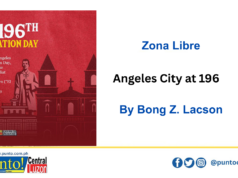Engine for development
San Agustin has relatively a small track of agricultural lands used for corn, rice and saba (a banana variety) production. It nevertheless boasts of having at least 6,000 native carabaos owned by the farmers. These carabaos proved to be the “saving grace” for the town. In 1993, the town’s officials seized the opportunity for a carabao upgrading program offered by the PCC thru its station at the Cagayan State University, in coordination with other agencies. The PCC station in Cagayan is located at a farther distance away.
The program deals with artificial insemination (AI) in carabaos using extended semen from superior Murrah and Bulgarian buffalo bulls produced at the PCC semen processing laboratory in Barangay Joson, Carranglan, Nueva Ecija.
“We got interested in it,” said Julio Lamug, San Agustin municipal agriculture officer. “Our mayor then, Jesus Silorio Sr., directed me to try it in our town,” he added.
He said the farmers were reluctant as they feared something bad may happen to their work animal. But when they saw the calves produced by the ten carabaos inseminated, their attitude changed. Over the years,
the number of farmers who wanted their carabaos given AI treatment multiplied several fold.
The AI treatment project was later augmented by the coming in of superior bulls loaned out by the PCC for natural mating. The succeeding mayors of the town adopted in their respective terms the carabao improvement program as the town’s banner project.
Mayor Padilla said he is setting the production of from 3,000 to 4,000 crossbreds up to 2015. He added that an 11-hectare government property is being eyed as an area for a “milk, meat, hide and horn processing center”.
Gov sees self
in carabao
Isabela Gov. Grace Padaca, in an interview at the capitol, said the carabao is a good symbol for this country and its people in many ways. She added that she is providing full support to the efforts of San Agustin town.
On a personal note, she said, she experienced riding on a carabao-drawn cart to reach a project high on the mountain side. She saw how the carabao trudged on knee-deep muddy trail step by step until they reached the place.
Padaca, who is physically disabled, said philosophically that she saw herself in the carabao.
“Its every step was a struggle, its every step was a success,” she said.
Padaca said she plans to develop a tillers’ village, similar to the one she saw in her visit to the United States, where the carabao and the carabao-powered farm implements would be the main feature.
Padilla agreed and he offered his whole town as a model.
Carabao
improvement
The PCC, which was established with the passage of Republic Act 7307 in 1992, is tasked to “conserve, propagate and promote the carabao as a source of draft animal power, meat, milk, and hide…”
With this mandate comes the aim of “better nutrition, higher levels of income and improved general well-being of the overwhelming sector, the rural farming families”.
It was the declining size, weight, and the population of the native carabaos that prompted then Sen. Joseph Estrada to author the “Carabao Act of 1992”.
“Broadly, our task is to pursue the genetic transformation of our native carabaos to produce improved breed for draft, milk, meat, hide and horn purposes,” Cruz said. “Through our 13 stations, technology transfer on the care and production of carabao, and teaching and encouraging rural families to engage in carabao enterprises, are similarly pursued,” he added.
The genetic transformation being done by PCC, after conducting thorough research and development, is thru the production of semen from imported superior bulls and distribution of it nationwide for artificial insemination (AI) to breeedable native carabaos.
It also uses reproductive biotechnology called embryo transfer technology, or the test-tube technique.
Added to these techniques is the PCC’s bull loan project where superior bulls are loaned out to the farmers for natural mating with the native female carabao.
Currently undertaken is the research and development on Somatic Cell Nuclear Transfer (SCNT) or cloning.
“It takes three generations or 15 years to attain 87.5 % genetic purity for the improved breed of native carabaos,” Cruz said. “The task of selecting, back crossing, infusing superior breed from abroad to further improve the already improved breed of carabaos in the country will go on,” he added.
The produced improved breed, which many like to call as “super carabaos”, reaches 750 kilograms. The female can yield 17 to 20 liters of milk a day.
The native carabaos have an average weight of 350 kg while its female can give only an average of 1.5 liters a day. The ex-farm price of the milk is from P35 to P40 a liter.
Cruz said the PCC aims to produce female carabaos which can approximate the best dairy carabaos in the world that yield about 35 liters of milk per day.
San Agustin has relatively a small track of agricultural lands used for corn, rice and saba (a banana variety) production. It nevertheless boasts of having at least 6,000 native carabaos owned by the farmers. These carabaos proved to be the “saving grace” for the town. In 1993, the town’s officials seized the opportunity for a carabao upgrading program offered by the PCC thru its station at the Cagayan State University, in coordination with other agencies. The PCC station in Cagayan is located at a farther distance away.
The program deals with artificial insemination (AI) in carabaos using extended semen from superior Murrah and Bulgarian buffalo bulls produced at the PCC semen processing laboratory in Barangay Joson, Carranglan, Nueva Ecija.
“We got interested in it,” said Julio Lamug, San Agustin municipal agriculture officer. “Our mayor then, Jesus Silorio Sr., directed me to try it in our town,” he added.
He said the farmers were reluctant as they feared something bad may happen to their work animal. But when they saw the calves produced by the ten carabaos inseminated, their attitude changed. Over the years,
the number of farmers who wanted their carabaos given AI treatment multiplied several fold.
The AI treatment project was later augmented by the coming in of superior bulls loaned out by the PCC for natural mating. The succeeding mayors of the town adopted in their respective terms the carabao improvement program as the town’s banner project.
Mayor Padilla said he is setting the production of from 3,000 to 4,000 crossbreds up to 2015. He added that an 11-hectare government property is being eyed as an area for a “milk, meat, hide and horn processing center”.
Gov sees self
in carabao
Isabela Gov. Grace Padaca, in an interview at the capitol, said the carabao is a good symbol for this country and its people in many ways. She added that she is providing full support to the efforts of San Agustin town.
On a personal note, she said, she experienced riding on a carabao-drawn cart to reach a project high on the mountain side. She saw how the carabao trudged on knee-deep muddy trail step by step until they reached the place.
Padaca, who is physically disabled, said philosophically that she saw herself in the carabao.
“Its every step was a struggle, its every step was a success,” she said.
Padaca said she plans to develop a tillers’ village, similar to the one she saw in her visit to the United States, where the carabao and the carabao-powered farm implements would be the main feature.
Padilla agreed and he offered his whole town as a model.
Carabao
improvement
The PCC, which was established with the passage of Republic Act 7307 in 1992, is tasked to “conserve, propagate and promote the carabao as a source of draft animal power, meat, milk, and hide…”
With this mandate comes the aim of “better nutrition, higher levels of income and improved general well-being of the overwhelming sector, the rural farming families”.
It was the declining size, weight, and the population of the native carabaos that prompted then Sen. Joseph Estrada to author the “Carabao Act of 1992”.
“Broadly, our task is to pursue the genetic transformation of our native carabaos to produce improved breed for draft, milk, meat, hide and horn purposes,” Cruz said. “Through our 13 stations, technology transfer on the care and production of carabao, and teaching and encouraging rural families to engage in carabao enterprises, are similarly pursued,” he added.
The genetic transformation being done by PCC, after conducting thorough research and development, is thru the production of semen from imported superior bulls and distribution of it nationwide for artificial insemination (AI) to breeedable native carabaos.
It also uses reproductive biotechnology called embryo transfer technology, or the test-tube technique.
Added to these techniques is the PCC’s bull loan project where superior bulls are loaned out to the farmers for natural mating with the native female carabao.
Currently undertaken is the research and development on Somatic Cell Nuclear Transfer (SCNT) or cloning.
“It takes three generations or 15 years to attain 87.5 % genetic purity for the improved breed of native carabaos,” Cruz said. “The task of selecting, back crossing, infusing superior breed from abroad to further improve the already improved breed of carabaos in the country will go on,” he added.
The produced improved breed, which many like to call as “super carabaos”, reaches 750 kilograms. The female can yield 17 to 20 liters of milk a day.
The native carabaos have an average weight of 350 kg while its female can give only an average of 1.5 liters a day. The ex-farm price of the milk is from P35 to P40 a liter.
Cruz said the PCC aims to produce female carabaos which can approximate the best dairy carabaos in the world that yield about 35 liters of milk per day.




